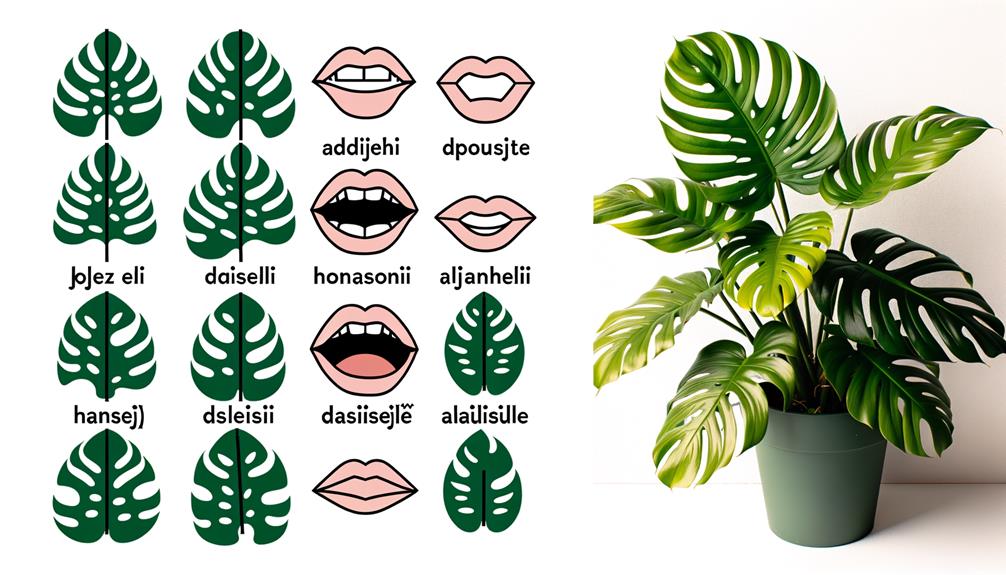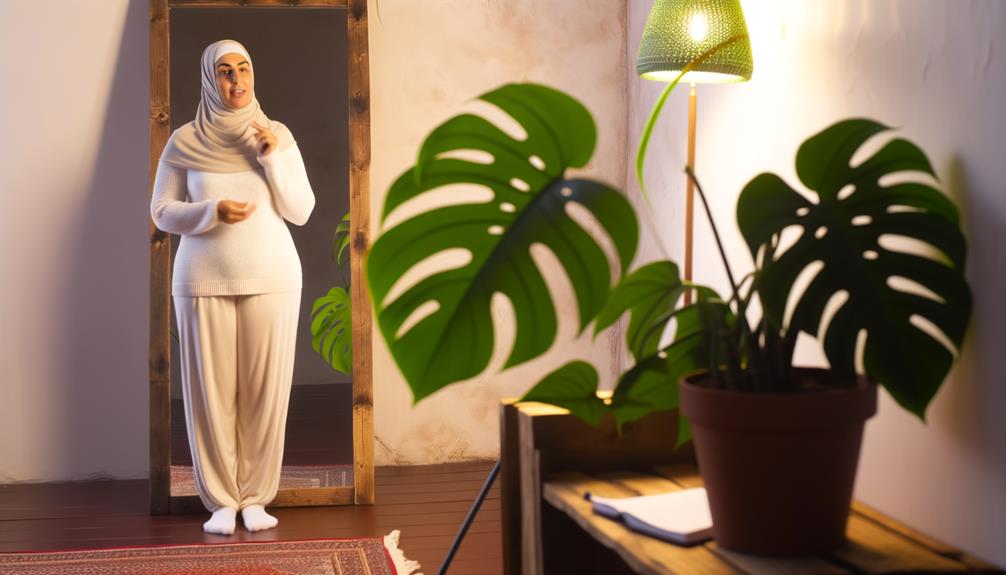How to Pronounce Monstera Adansonii
Pronounce 'Monstera Adansonii' by breaking it into syllables. Start with 'mon-STEER-uh' for 'Monstera', emphasizing the second syllable.
Then move to 'add-an-SOH-nee-eye' for 'Adansonii', highlighting the 'SOH' and 'eye' syllables. Accurate pronunciation requires stress on the capitalized segments.
Common errors arise from incorrect syllable emphasis or misinterpreting Latin phonetics. Practice by repeating the name, recording yourself, and using mnemonic devices.
Mastery ties you closer to the botanical roots, named after the botanist Michel Adanson. With each accurate repetition, you gain deeper respect for the plant and its scientific heritage.
Discover more nuanced insights next.

Key Takeaways
- Pronounce 'Monstera Adansonii' as 'mon-STEER-uh add-an-SOH-nee-eye'.
- Break the name into syllables: 'mon-STEER-uh' and 'add-an-SOH-nee-eye'.
- Emphasize the capitalized syllables for correct pronunciation.
- Practice regularly and use online audio guides for accurate pronunciation.
- Record yourself saying it to identify and correct any errors.
Breaking Down 'Monstera'
To pronounce 'Monstera' accurately, you need to break it down into its syllabic components: 'Mon-ste-ra'. Start with 'Mon', which sounds like the beginning of 'monster'.
Next, 'ste' is pronounced like 'stay' without the 'y'.
Finally, 'ra' should sound like 'rah', maintaining a soft 'a'.
This phonetic breakdown will guide you to articulate the botanical name correctly.
Remember, emphasis is typically on the first syllable, 'Mon', giving it a slight prominence over the others.
Precision in pronunciation is essential, especially in scientific contexts where miscommunication can lead to misunderstandings.
Practice saying 'Mon-ste-ra' slowly, then gradually increase your speed while maintaining clarity.
Correct pronunciation reflects your attention to detail and respect for botanical nomenclature.
Understanding 'Adansonii'
You'll find that 'Adansonii' is named after the French botanist Michel Adanson, reflecting its historical roots in botanical nomenclature.
Breaking it down phonetically, you pronounce it as ah-dan-SOH-nee-eye.
Common mistakes include misplacing the stress or elongating the vowels, leading to inaccuracies in pronunciation.
Origin of 'Adansonii'
Have you ever wondered why the species name 'Adansonii' was chosen for this particular Monstera?
The name 'Adansonii' honors the French botanist Michel Adanson, renowned for his extensive work in plant taxonomy during the 18th century. Adanson's contributions to systematic botany and his meticulous plant classifications earned him this botanical commemoration.
The Monstera adansonii, with its characteristic fenestrated leaves, exemplifies the scientific tradition of naming species after eminent figures in natural history. This practice not only acknowledges their contributions but also embeds their legacy within botanical nomenclature.
Understanding the origin of 'Adansonii' helps you appreciate the rich historical context behind this beloved plant species, linking it to the broader tapestry of botanical science.
Phonetic Breakdown Guide
Pronouncing 'Adansonii' involves breaking it down into its component syllables: ah-dan-SOH-nee-eye.
Start with 'ah,' an open, relaxed vowel sound. Follow with 'dan,' stressing a short, crisp 'a.' The third syllable, 'SOH,' requires emphasis—guarantee it stands out by elongating the 'o.'
Next, 'nee' is pronounced with a long 'e,' similar to the word 'knee.' Finally, end with 'eye,' resembling the organ of vision.
This phonetic breakdown helps you articulate each part correctly, ensuring scientific precision. By focusing on these detailed descriptions, you'll master the pronunciation of 'Adansonii,' reflecting its botanical nomenclature accurately.
This meticulous approach aids in avoiding common errors and ensures your pronunciation aligns with academic standards.
Common Pronunciation Mistakes
A common mistake when pronouncing 'Adansonii' is misplacing the emphasis on the wrong syllable, often leading to an incorrect accent that distorts its scientific accuracy. The name should be emphasized on the third syllable, 'son,' guaranteeing clarity and precision. Mispronunciations can impact the interpretation and communication among enthusiasts and professionals.
| Incorrect Pronunciation | Correct Pronunciation |
|---|---|
| A-dan-SO-nii | A-dan-SON-ii |
| A-DAN-son-ii | a-DAN-son-ii |
| a-DAN-so-nii | a-DAN-SON-ii |
| A-dan-so-NII | a-dan-SON-ii |
Placing the emphasis correctly helps maintain the botanical name's integrity and ensures effective communication. Pay attention to the stress pattern to avoid common pitfalls.
Phonetic Guide

To guarantee accurate pronunciation of 'Monstera Adansonii,' you'll need to focus on the phonetic breakdown of each syllable.
The correct pronunciation is 'mon-STEER-uh add-an-SOH-nee-eye,' with emphasis on the capitalized syllables.
We'll also address common mispronunciations that might hinder effective communication.
Phonetic Breakdown
Understanding the phonetic breakdown of 'Monstera Adansonii' involves dissecting each syllable for accurate pronunciation: /mɒnˈstɪərə/ and /ˈædænsˈoʊni.aɪ/.
First, pronounce 'Monstera' by stressing the second syllable: 'mon-STEER-uh.' The 'o' in 'mon' is a short sound, akin to 'mop.' The 'steer' part uses a long 'e' sound.
For 'Adansonii,' stress the second and the fourth syllables: 'ad-an-SOH-nee-eye.' The initial 'a' is short, followed by 'dan' with a short 'a.' 'Soh' carries a long 'o' sound, and 'nee' uses a long 'e.' Finally, 'eye' sounds like the pronoun 'I.'
Break it down syllable by syllable to master the pronunciation with precision and confidence.
Common Mispronunciations
Common mispronunciations of 'Monstera Adansonii' often arise from incorrect syllable emphasis and vowel length, leading to confusion and miscommunication.
To help you avoid these pitfalls, let's dissect the common errors:
- Misplacing Emphasis: You might stress the first syllable of 'Adansonii' (ə-DAN-so-nee-eye) instead of the second (ad-AN-so-nee-eye), causing a notable mispronunciation.
- Incorrect Vowel Length: Shortening the 'ee-eye' sound at the end to a simple 'ee' (ad-AN-so-nee) alters the word's phonetic integrity.
- Dropping Syllables: Omitting the 'ra' in 'Monstera' (MON-stee) truncates the name, making it unrecognizable.
Common Pronunciation Mistakes
Mispronouncing 'Monstera adansonii' often stems from incorrect emphasis on syllables or misinterpreting the Latin roots. You might place stress on the wrong syllable, saying 'mon-STE-ra' instead of 'MON-stera.' The correct pronunciation emphasizes the first syllable.
Additionally, 'adansonii' can be tricky; many falter by saying 'a-DAN-so-nee' instead of the accurate 'a-dan-SON-ee-eye.' This mistake happens because of unfamiliarity with Latin pronunciation conventions. The suffix '-ii' in Latin names is pronounced 'ee-eye,' not simply 'ee.'
Misinterpretations can lead to 'mo-STER-a' or 'a-dan-SO-nee,' both incorrect. Understanding these nuances helps you pronounce 'Monstera adansonii' correctly, which is essential for scientific communication and botanical discussions.
Practice Makes Perfect

To master the pronunciation of 'Monstera adansonii,' you need to engage in consistent and deliberate practice, paying close attention to syllable stress and Latin phonetic rules. Emphasize the correct syllables: 'Mon-STEH-ra a-dan-SOH-nee-eye.'
Follow these steps:
- Break it Down: Pronounce each component separately: *Mon-STEH-ra* and *a-dan-SOH-nee-eye*. This helps isolate and understand individual sounds.
- Repeat Regularly: Daily repetition reinforces muscle memory. Recite the name multiple times, focusing on accuracy.
- Record and Playback: Use a recorder to capture your pronunciation. Compare it to a native speaker's version, identifying discrepancies.
Tips for Remembering
Once you've practiced consistently, mnemonic devices can greatly help in cementing the correct pronunciation of 'Monstera adansonii' in your memory.
Start by breaking it into syllables: Mon-ste-ra a-dan-so-nii. Visualize 'Mon' as in 'monster,' 'ste' like 'stair,' and 'ra' as 'rah.'
For 'adansonii,' think of 'a-dan' as in 'a dance' and 'so-nii' like 'so-knee.' Create a mental image: a monster dancing on stairs, with a knee prominently featured.
Repetition of this vivid imagery will solidify the pronunciation. Additionally, try spelling it out phonetically during practice sessions.
The key lies in integrating these mnemonic devices into your daily routine, ensuring that 'Monstera adansonii' becomes second nature in both recollection and pronunciation.
Conclusion
Mastering the pronunciation of 'Monstera adansonii' isn't rocket science. By breaking down the words, using the phonetic guide, and actively practicing, you'll nail it in no time.
Remember, practice makes perfect. Avoid common mistakes, and you'll sound like a botanical expert. Think of it as a linguistic puzzle; once solved, it's a piece of cake.
Keep practicing, and soon, you'll confidently articulate 'Monstera adansonii' with scientific precision and ease.






